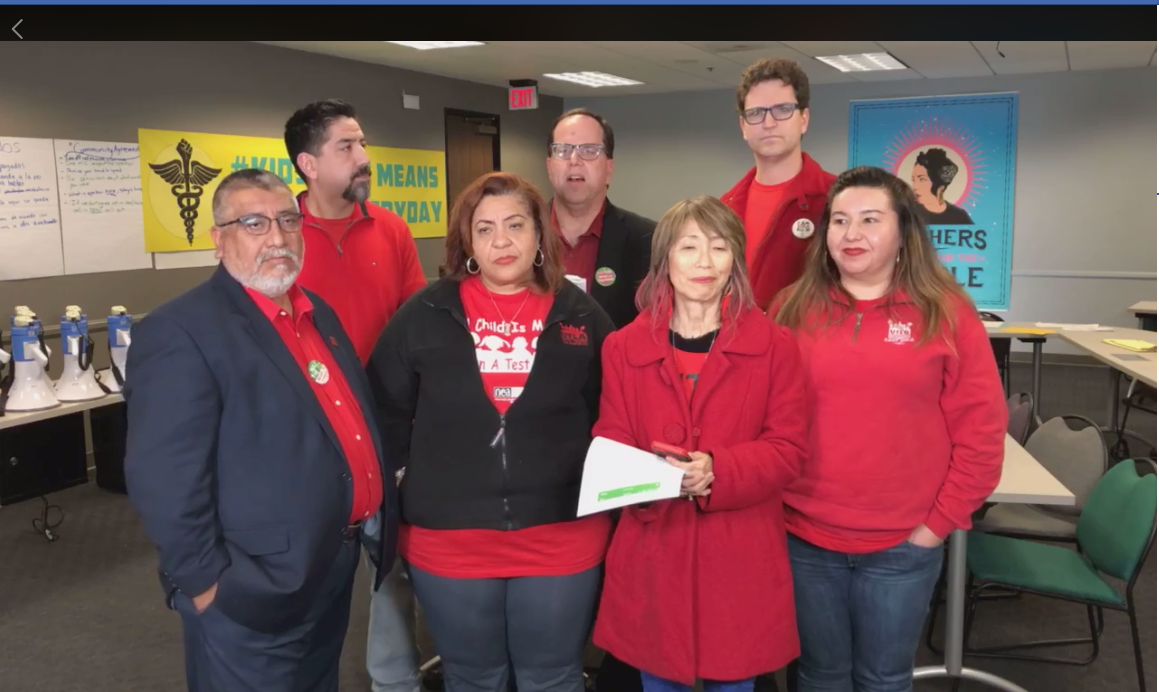
High School Students in School. (Photo: Monkey Business Images/Shutterstock)
How the Teachers Union Can Save LA Unified
What’s so terrible about a ‘market based scheme for public schools?’
By Edward Ring, September 9, 2022 2:50 am
Earlier this year the United Teachers of Los Angeles (UTLA) released a report entitled “Burned Out, Priced Out – Solutions to the Educator Shortage Crisis.” Given the universally acknowledged challenges facing public K-12 education in California, this report merits serious attention.
The UTLA represents teachers in the Los Angeles Unified School District, which with over 500,000 enrolled K-12 students is the 2nd largest school district in the United States. How severe is their teacher shortage?
According to statements made by Superintendent Alberto M. Carvalho in August, there are 900 teacher vacancies. To put this in perspective, according to LAUSD’s “Fast Facts” for the 2022-23 school year, there are 502,850 K-12 students enrolled in LAUSD, and 23,553 K-12 teachers. This means the student/teacher ratio without hiring 900 more teachers is 21.3 students per teacher, and once those hires are made, that ratio will shrink to 20.5 students.
Without knowing where these vacancies are concentrated – not enough STEM or AP teachers? – this does not appear to be a crisis. In fact, according to Cal School News, LAUSD enrollment is projected to drop by nearly 30 percent over the next decade. LAUSD needs to be planning to reduce teacher headcount, not increase it.
So is there really a teacher shortage in LAUSD? The UTLA may have inadvertently admitted their credibility is not unassailable when in the first introductory sentence of their report, they claim “a bipartisan political campaign has been waged against professionalism and greater spending on public education.” Key word: “bipartisan.” The teachers unions are one of the most powerful political players in Sacramento. If they now believe they’re encountering bipartisan opposition, maybe it’s because even some of their most relied upon politicians can no longer always support them.
The UTLA report goes on to list three factors driving the alleged teacher shortage crisis: (1) increased expectations of educators without essential support for the communities they serve, (2) state imposed testing that limits teacher autonomy, and (3) inadequate salaries compared to other professions. Let’s start with salaries.
The most recent salary data available for LAUSD teachers, posted by the State Controller, is for 2020. In that year, the average base pay for an LAUSD teacher was $80,156. Add to that “other pay,” and their W-2 average salary was $87,057. The value of their health insurance and employer contribution to their pension added another $28,889, to make their total compensation $115,946. How does this compare to other professionals?
A good place to start would be the Los Angeles County workforce, the vast majority of whom are professionals with a college degree required. Excluding firefighters and sheriffs, the average full time employee working for LA County made total pay of $95,702 in 2020, although that includes $2,804 in overtime. Their total compensation including benefits was $122,764, putting them 6 percent ahead of teachers. Neither LAUSD nor LA County included payments on their substantial unfunded pension liabilities in their employee benefit costs, so in both cases, these employees earned more in 2020 than what was reported by the State Controller.
It is important to stress that when evaluating professional compensation in the public sector, the most valid comparisons are between public agencies. This is because public sector workers do not put in nearly the same amount of time at work as private sector workers. For example, according to the LAUSD calendar for the 2022-23 school year, teachers will actually teach for 185 days – they get a week off at Thanksgiving, three weeks off at Christmas, a week off for Spring Break, and eight weeks off for summer, plus numerous individual holidays. Must be nice.
Compare this to non-safety professionals in LA County, where a veteran employee will get 10 holidays, four weeks vacation (after 13 years), some departments allow employees to convert excess sick leave into additional vacation days, and many even have the so-called “9/80” program, where if they work nine hour days, every two weeks they get a paid day off. But even if you consider those 26 days off pursuant to the 9/80 program as paid days off, you still have veteran LA County employees putting in about 200 workdays per year, which is 8 percent more than LAUSD teachers.
None of this comes close to describing private sector reality, of course. Even in very large corporations, where one may assume after 10+ years the employees will get 20 days vacation, you’re looking at at least 230 workdays per year. In small businesses, more than two weeks vacation is rare, as is recognition of as many as 10 paid holidays, but even if so, that’s 240 workdays per year. And then there are owners of very small businesses and independent contractors, who don’t get paid if they don’t work, and pay for their benefits out of whatever they can earn. Expect them to work 250+ days per year, and if, as is not unusual the private sector, they work six day weeks, expect them to work up to 300+ days per year.
Teachers in Los Angeles ought to consider their salary and benefits in comparison not only to their fortunate counterparts who work for Los Angeles County, but to those private sector working households who pay the taxes that support them and who rely on them to teach their children. In 2020 the median household income (often more than one wage earner per household) in Los Angeles County was $72,750. That’s what working families have between them and the world.
Which brings us to the other two primary concerns noted by UTLA in their report: Too many standardized tests, and inadequate support for the communities where the students live. With respect to standardized tests, the UTLA may have a point, but their solution – eliminate all standardized assessments that are not state or federally required – only goes half way.
If the UTLA is serious about ensuring that academically qualified students advance into the appropriate institutions of higher education, they will give those remaining state and federally required standardized tests the importance they deserve. They will lobby the state to return to college admissions that rely heavily on SAT scores. They may also support a return to standardized testing for admission to graduate schools and before granting professional credentials, whether it’s the LSAT, the MCAT, the Bar Exam, or the U.S. Medical Licensing Exam.
As for “equity for schools and communities,” UTLA recommends every school have a nurse, a fully staffed library, manageable class sizes, special education caseload caps, and “more counselors, PSWs, PSAs, and psychologists.” What that all means, and to what degree it is already in place or to what further degree it may be implemented is a matter for legitimate debate. But UTLA doesn’t stop there, adding:
“LAUSD must support housing, environment, immigration, and COVID-19 recovery needs for school families and the broader community, and “reject all market-based schemes for our public schools and creation of an Equity System to identify equity gaps in the district and create plans for increasing equity.”
Here is where the ideology of the UTLA, and by extension, the teachers union leadership throughout California, is in conflict with common sense solutions that might be far more effective. What’s so terrible about a “market based scheme for public schools?” Is this an attack on charter schools? Is this taking a shot at school choice, education savings accounts, and school vouchers? If so, UTLA and the unions may soon be standing on the wrong side of history, because those approaches have proven to be good for students.
As for “increasing equity,” an innocent reading might find this as merely the wish to see more funding go to underfunded schools in low income communities. Notwithstanding that “market based schemes” might rescue schools in low income communities more effectively than just throwing more money at public schools, this is a reasonable aspiration. But unfortunately, “equity” has come to mean demanding privileges and preferences for any group that can be identified as having some achievement gap between it and any other group. These equity mandates are flawed because they ignore countless possible causes of disparate group outcomes, many of which have nothing to do with a legacy of discrimination or disenfranchisement.
In that context, consider UTLA’s most ambitious proposed solution, to “support housing, environment, immigration, and COVID-19 recovery needs for school families and the broader community.” This goes well beyond the purpose of public education, which is to educate, but it doesn’t go beyond the scope of the broader political agenda of the teachers union, or the political coalition they’re part of.
If the teachers union wants to help low income communities, they can promote the intact nuclear family as the variable that contributes the most to chances that a child will succeed in life. They can identify and condemn thug culture, and demand respect from the street for academic achievement. They can recognize that viable classroom size can be greatly expanded when disruptive students are removed to classes or schools where their special needs or disciplinary challenges can be more efficiently addressed. They can emphasize marketable skills in their curricula and dispense with all the political indoctrination that not only embitters otherwise promising students, but teaches them absolutely nothing useful.
And as for the crippling cost-of-living that leads UTLA leadership to demand higher pay, recognize that everyone is a victim of an exploding cost-of-living, and the reason everything costs too much is a direct consequence of the policies enacted by the political coalition they support. To lower the cost of housing, for example, abolish the ridiculously overwritten building code requirements, relax the zoning laws that prohibit urban expansion, quit charging criminally high fees for building permits, and deregulate the industries that supply building materials. That would be a good place to start, but the same principles apply to prices for energy, water, and food.
The UTLA is a powerful organization. They might consider using their influence to fight for programs and policies that will actually work, instead of hewing to a failed ideology and tired rhetoric.
- Ringside: Long Term Electricity Storage - July 23, 2025
- Ringside: One Way to Avoid Gasoline Lines in 2026 - July 18, 2025
- Ringside: Is California’s Water Infrastructure Ready for Climate Whiplash? - July 10, 2025








Los Angeles Unified Schools are a disaster where schools have become leftist indoctrination centers filled with surly unionized teachers who are more like prison guards. Parents should do everything they can to have their kids educated elsewhere?
It ain’t the pay – it’s the unruly youngsters that run wild because their parents either had them out of obligation, have to work three jobs to feed them, or want to be their friends, not their parents…
You couldn’t pay me enough to go NEAR an LAUSD facility….
The LAUSD pulling this daily pass(covid passport) on the children I refused to have my kids swabbed just to attend school and moved them out of the corrupt LAUSD for good .Witnessed first hand during the bogus virtual learning at home how Marxist these teachers have become teaching kids why one group of people is responsible for another’s oppression (critical race theory) teaching kids to blame white people for everything …CaliforniaInsider on YouTube has done great work exposing the corruption in the LAUSD trying to forcefully vaccinate our kids with a deadly injection